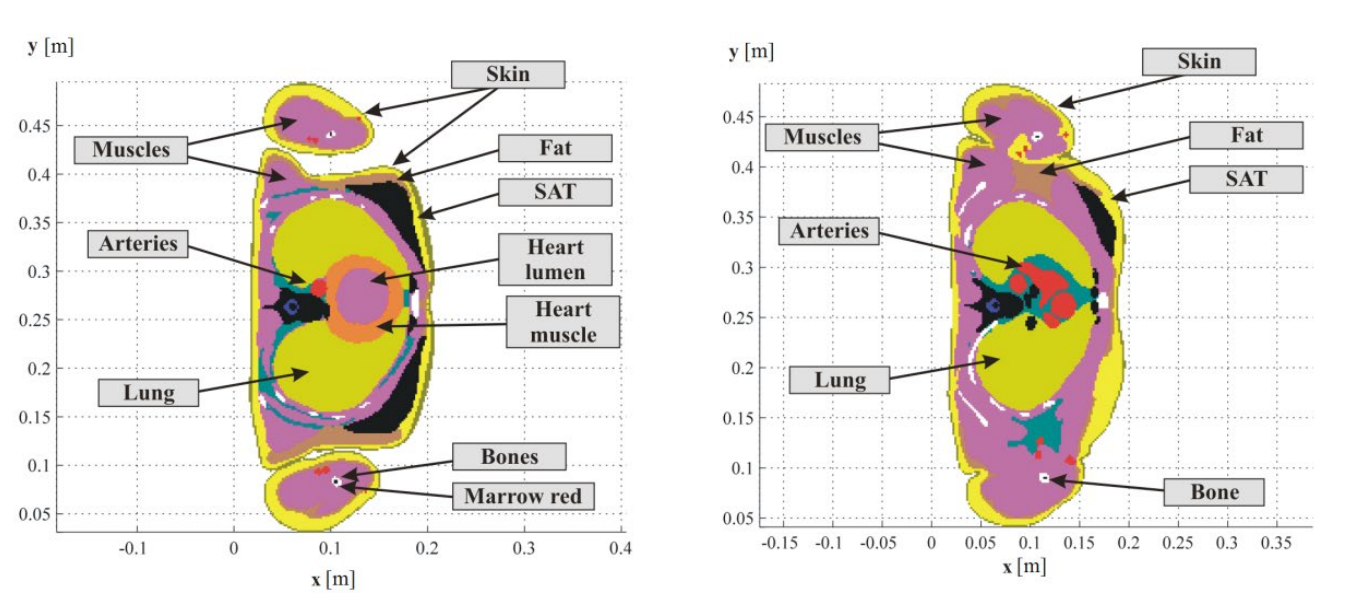Possible interactions between stent and electromagnetic field
DOI:
https://doi.org/10.5604/01.3001.0012.8156Słowa kluczowe:
magnetotherapy, stents, biomedical devices, power linesAbstrakt
Over the past years, an increase in the amount of the electromagnetic sources could be observed. Model presented in this article is limited to the impact of low frequency fields generated by the e.g. electrical power lines or magnetic coils in a bone fractures therapy. Particularly, the effect of the magnetic component of the electromagnetic field on stents will be evaluated. The conductivity of human tissues will be investigated. Yielded results will be used to simplify complicated, three-dimensional problem of the current distribution in stent branches, to one-dimensional one. The merits of the paper is proposing, implementing and using for analysis a numerical model of the stent in magnetic field. The impact of frequency and positioning of stent in the magnetic field will be investigated and current distributions found.
Statystyka pobrań
Bibliografia
Lunca E., Istrate M., Salceanu A., Tibuliac S.: Computation of the magnetic field exposure from 110 kV overhead power lines; 2012 International Conference and Exposition on Electrical and Power Engineering, Iasi, 2012, p. 628–631. Google Scholar
Lunca E., Istrate M., Salceanu A.: Comparative Analysis of the Extremely Low-Frequency Magnetic Field Exposure from Overhead Power Lines, Environmental Engineering and Management Journal, 2013; 12(6):1145–1152. Google Scholar
Bienkowski P., Podlaska J.: Electromagnetic field in the environment – measurement and monitoring in Poland, Przeglad Elektrotechniczny, 2017; 93(12):71–74. Google Scholar
WalshE. G., VenugopalenR., MRI stent, University of Alabama, Birmingham, 2004 [5] Ciesla A., Kraszewski W., Skowron M., Syrek P.: Determination of safety zones in the context of the magnetic field impact on the surrounding during magnetic therapy, Przeglad Elektrotechniczny, 2011; 87(7): 79–82. Google Scholar
International Commission on non-ionizing Radiation Protection: Statement on Medical Magnetic Resonance (MR) Procedures: Protection of Patients, Health Physics, 2004; 87(2):197–215. Google Scholar
Zradzinski P.: A comparison of ICNIRP and IEEE guidelines to evaluate low frequency magnetic field localised exposure,2016 17th International Conference Computational Problems of Electrical Engineering (CPEE), Sandomierz, 2016, p. 1–4. Google Scholar
Christ A., et al.: The Virtual Family – Development of surface-based anatomical models of two adults and two children for dosimetric simulations, Physics in Medicine and Biology, 2010; 55(2):23–38. Google Scholar
Dimbylow P.: Development of the Female Voxel Phantom, NAOMI, and Its Application to Calculations of Induced Current Densities and Electric Fields From Applied Low Frequency Magnetic and Electric Fields, Physics in Medicine and Biology, 2005; 50:1047–1070. Google Scholar
Parazzini M., Fiocchi S., Cancelli A., Cottone C., Liorni I., Ravazzani P., A Computational Model of the Electric Field Distribution due to Regional Personalized or Nonpersonalized Electrodes to Select Transcranial Electric Stimulation Target, IEEE Transactions on Biomedical Engineering, 2017; 64(1):184–195. Google Scholar
Gabriel C., Peyman A., Grant E.H., Electrical Conductivity of Tissue at Frequencies Below 1 MHz, Physics in Medicine & Biology, 2009; 54(16):4863–4878. Google Scholar
Bolkowski S.: „Teoria obwodów elektrycznych”, Warszawa, Wydawnictwa naukowo-techniczne, 2003. Google Scholar
Halliday D., Resnick R., Walker J.: Fundamentals of Physics, New York, John Wiley & Sons, 1997. Google Scholar
Cieśla A.: Elektrotechnika elektryczność i magnetyzm w przykładach i zadaniach, Wydawnictwa AGH, Kraków 2006. Google Scholar
Paszenda Z., Marciniak J., Będziński R., Rusiński E., Smolnicki T.: Biomechanical characteristics of the stent – coronary vessel syste m. Acta of Bioengineering and Biomechanics, 2002; 4(1):81089. Google Scholar
Guadagnin V., Parazzini M., Fiocchi S., Liorni I., Ravazzani P., Deep Transcranial Magnetic Stimulation: Modeling of Different Coil Configurations, IEEE Transactions on Biomedical Engineering, 2016; 63(7):1543–1550. Google Scholar

Pobrania
Opublikowane
Jak cytować
Numer
Dział
Licencja
Prawa autorskie (c) 2018 Państwowa Wyższa Szkoła Zawodowa w Tarnowie & Autorzy

Utwór dostępny jest na licencji Creative Commons Uznanie autorstwa – Użycie niekomercyjne 4.0 Międzynarodowe.



